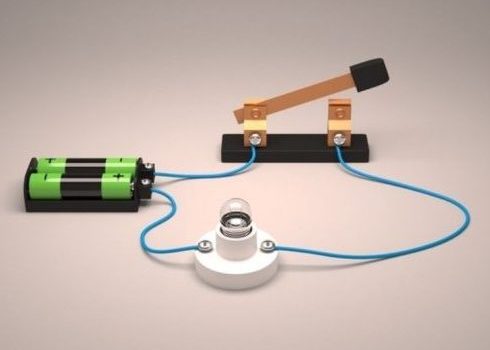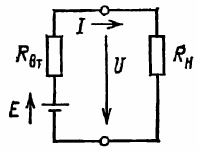Power ratio in the simplest electrical circuit
In this article, we will understand what the ratio of the source and receiver parameters should be in order to achieve the optimal mode of operation of the electrical circuit. Power ratios are also important for low current technologies. In principle, these questions can be addressed with the help of the example the simplest electrical circuit.

The circuit consists of a source of direct current with EMF E and internal resistance Rwatt, which generates electrical energy, and a receiving energy receiver with load resistance Rn.

Rice. 1. Schematic to explain the power ratio in the simplest circuit
Since the source has internal resistance, then some of the electrical energy it develops is converted into heat energy itself.
The current in the circuit shown in Fig. 1

Based on this equation, we determine the power of the receiver (the power of converting electrical energy into other types):

Similarly, the power losses in the source:

The electrical power of the source must be equal to the sum of the powers converted to other types in the source and receiver, i.e. there must be a power balance (as for all circuits):

The terminal voltage U can also be entered in the expression for the power Pn.
Receiver Power:

Coefficient of performance (COP), defined as the ratio of receiver power (useful) to developed power:

The equation shows that efficiency depends on the ratio of load resistance to internal resistance. The values of these resistances are the determining factor in the distribution of the power developed by the source:

The power Pn should be considered useful, the power losses in the source Pvt determine only the heating of the source and therefore the corresponding energy is spent unproductively.
Efficiency increases with increasing Rn / Rvt ratio.
In order to obtain a large efficiency value, the ratio Pn> Pwt must be fulfilled, that is, the circuit must operate in a mode close to to source idle mode.
In practice, two different power ratio requirements can be set: high efficiency and power matching. The requirement for high efficiency is set, for example, when it is necessary to transmit a large amount of energy over wires or to convert this energy into electrical machines. Even a small increase in efficiency yields big savings in such cases.
Since the use of high energies is mainly characteristic of the technique of high currents, therefore in this field it is necessary to work in modes close to the idle mode.In addition, when operating in such modes, the terminal voltage differs only slightly from the source emf.
In low current technology (especially in communication technology and measurement technology) very low power sources are used, which in addition have large internal resistance… In such cases, the efficiency that characterizes the power transmission process is often of secondary importance, and the requirement for the maximum possible value of the power received by the receiver is emphasized.
While in high current technology useless or even harmful energy conversions - energy losses are reduced with increasing efficiency, in low current technology the efficiency of using plants and devices is increased with the correct coordination of powers in electrical circuits.
The condition for obtaining the maximum possible receiver power Pvmax from a source with EMF and internal resistance data:

It follows from this that the condition for the maximum power of the receiver is fulfilled subject to the equality Rn = RВt
Thus, when the resistances of the receiver and the internal resistance of the source are equal, the power received by the receiver is maximum.
If Rn = Rw, then

For the power received by the receiver, we have:

An example. With the help thermoelectric converter (thermocouples) with an internal resistance Rw = 5 ohms, you can get a voltage of 0.05 mV / ° C. The largest temperature difference is 200 ° C. What electrical data should an indicating electrical device have (resistance, power, current) if wants to get maximum power from the converter.
Give a solution for two cases:
a) the device is connected directly to the converter;
b) the device is connected using two copper wires of length l= 1000 m each with a cross-sectional area C = 1 mm2.
Answer. The maximum voltage at the terminals of the thermoelectric converter is equal to its EMF E = 200 * 0.05 = 10 mV.
In this case, the indication for the device connected to the circuit should be maximum (at the upper measurement limit).
a) In order for the power of the device to be maximum, it is necessary to match the resistances of the device and the converter. For this purpose, we choose the resistance of the device Requal to the resistance of the thermocouple, i.e. Rn = Rt = 5 ohms.
We find the maximum power of the device:

Determine the current:

b) If the resistance of the wires cannot be neglected, it must be taken into account when determining the total internal resistance of an active two-terminal device consisting of a thermocouple and two wires, since otherwise there is a mismatch between the receiver and the source with respect to of power.
Let's find the resistance of the wires, given that the specific resistance is 0.0178 μOhm-m:

Thus, the required resistance level of the device is:

At this value of internal resistance, the power of the device will be maximum

Circuit Current:

The obtained results show that it is advisable to choose sources with a low value of internal resistance, and the cross-sectional area of the connecting wires should be large enough.
Very often, when performing such measurements, the calculation of the coincidence of the receiver and the source comes down to the fact that from the available instruments the one is selected that, for a given or known maximum value of the measured value, obtains the largest deflection of the arrow and therefore provides the largest scale reading accuracy.
